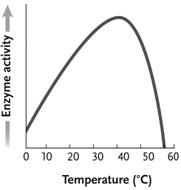Multiple Choice
 Figure 6.3
Figure 6.3
In the accompanying figure, why does the curve sharply drop after approximately 45°C instead of mirroring the slope of the line going from 0-40°C?
A) At high temperatures, the reactions proceed so quickly that enzymes are no longer helpful or required.
B) This is true of all catalysts and is not due to any special features of enzymes.
C) The kinetic energy of the reactants is so great that it destabilizes the enzyme and diminishes the enzyme's activity.
D) The kinetic energy of the reactants is lower than that of the products, forcing a change in enzyme activity.
E) The enzyme begins to denature above a certain temperature, eliminating all catalytic activity of the protein.
Correct Answer:

Verified
Correct Answer:
Verified
Q73: Energy from ATP is transferred to the
Q74: Zhang and Cech's experiments confirmed which feature
Q75: In an exothermic reaction, _.<br>A) ATP is
Q76: Enzymes are _ catalysts.<br>A) protein<br>B) lipid<br>C) nucleic
Q77: Which reaction is most likely to have
Q79: <img src="https://d2lvgg3v3hfg70.cloudfront.net/TBX8681/.jpg" alt=" Figure 6.4 Answer
Q80: What happens to an enzyme after it
Q81: The potential energy in a chemical bond
Q82: The conversion of a diamond into graphite
Q83: Enzymes don't change the DG of a